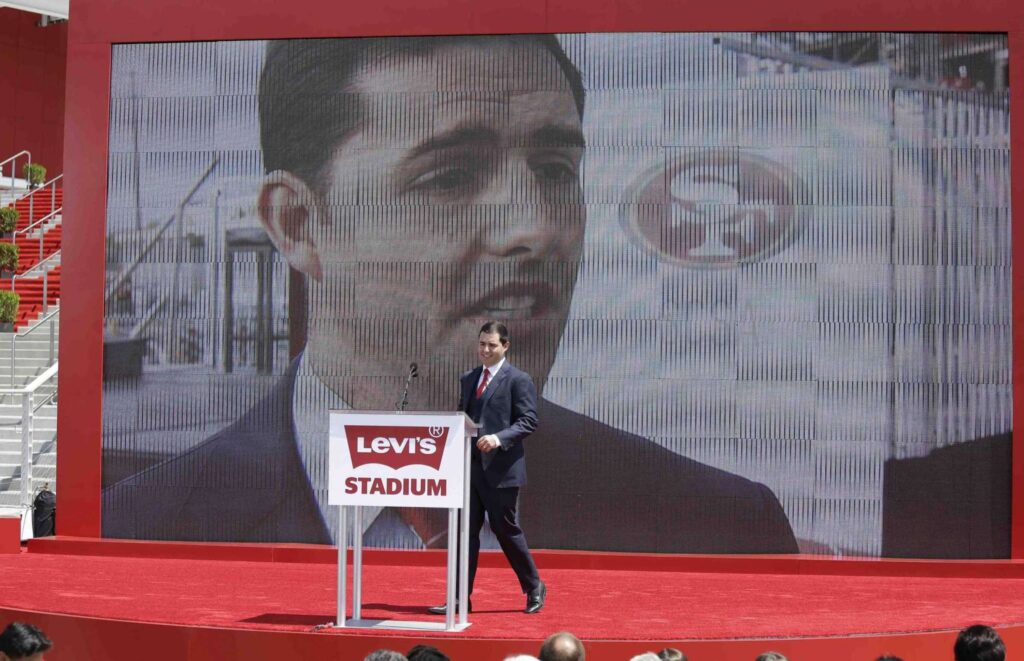
Jed York spent nearly $3 million last year, or more than $200 per vote, to help elect a 49ers-friendly majority to the City Council. Now team executives meet with some council members more than once a week, according to public records.
More than a decade ago, before they became adversaries in the most contentious team-city relationship in professional sports, Jed York and Lisa Gillmor were allies in the campaign to build an NFL stadium in Santa Clara.
Gillmor, then a real estate broker and 49ers volunteer, hosted one of many small gatherings where York, then the team’s 20-something CEO, urged voters to pass the stadium measure on the June 2010 ballot. Gillmor invited about 20 neighbors, scattered chairs around her living room and served hors d’oeuvres.
York spoke about the many benefits a stadium would bring to the city. Gillmor’s skeptical neighbors peppered him with questions. His answers seemed sincere, she recalled, and laced with concern for the community.
“I really thought the stadium was going to be a great thing,” Gillmor, now Santa Clara’s mayor and leading 49ers critic, said in a recent interview. “I still think it can be, just without them in charge. They need to be out of the way.”
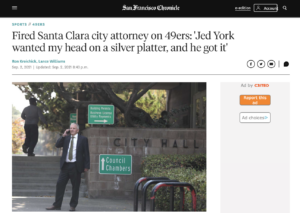
On Thursday, one day after the City Council fired City Attorney Brian Doyle, who was defending Santa Clara in eight legal actions brought by the team, 49ers spokesperson Rahul Chandhok said, “Doyle and Mayor Gillmor have been pushing misinformation to deflect from the damage they have done to Santa Clara’s finances. … What you hear from Gillmor are attacks to settle a personal vendetta.”
This acrimony began even before $1.3 billion Levi’s Stadium opened in 2014. What started with hopes of a civil partnership, producing revenue streams to enrich both the city and 49ers, has dissolved into a series of endless conflicts. At the heart of the fractured relationship are bitter charges and countercharges of financial improprieties, broken promises and allegations of illegal activity over operation of the stadium.
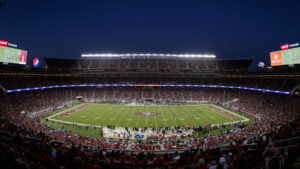
The first major public revelations about a rift came in 2016, after a civil grand jury conducting regular reviews of county financial issues recommended an audit of the stadium’s finances. The city’s Stadium Authority owns Levi’s Stadium but leases the facility to the 49ers, who run it through their Forty Niners Stadium Management Co. That company is supposed to make financial reports to the city so they can split profits, which the city deploys to pay off bonds used to build the stadium.
In 2017, City Manager Deanna Santana ordered the audit recommended by the grand jury, which led the city to contend it was not getting its fair share of the money, an accusation the team has denied. Santana followed by ordering more audits over the years, and eventually the 49ers started taking the city to court or arbitration over financial issues.
This saga offers a cautionary tale about the often fragile coexistence between pro sports teams and their home cities. Bay Area fans are all too familiar with the awkward tap dance, most recently in the A’s protracted efforts to obtain approval for a new waterfront ballpark in Oakland.
But the 49ers-Santa Clara feud includes a fresh dynamic: the team’s involvement in local politics. York spent nearly $3 million last year, or more than $200 per vote, to help elect a 49ers-friendly majority to the City Council. Now team executives meet with some council members more than once a week, according to public records.
Doyle, before his firing Wednesday, had repeatedly clashed with the 49ers since his hiring in 2017. He used the revenue dispute to argue the team was withholding millions that should have been shared with taxpayers.
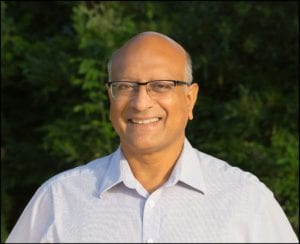
“49ers would like to see Brian Doyle gone.”
Santa Clara City Council Member Sudhansu “Suds” Jain
One council member, Sudhansu “Suds” Jain, said at a public meeting in April that 49ers executives had told him they wanted Doyle “gone.” When that happened last week, Doyle fired back by saying, “Jed York wanted my head on a silver platter, and he got it.”
“The 49ers’ response is to try to make Santa Clara a 19th-century company town,” said Roger Noll, a Stanford economics professor emeritus and expert on stadium financing. “That’s just not going to work. It may buy them a year or two, but it’s not a viable, long-term solution.”
Doyle’s dismissal and many residents’ alarmed reaction to it underscored the depth of trouble between Santa Clara and its highest-profile company. The conflict pits York, son of the team’s co-owners, against Gillmor, daughter of a wealthy real estate executive and former three-term mayor of this 128,000-resident, high-tech hub. Nearly $400 million is at stake, public records show.
A detailed review of court records, interviews with city officials and email exchanges with Chandhok, the 49ers spokesperson, found little on which the team and city agree.
Among the flash points:
• Plunging revenues: The 49ers and the Stadium Authority were supposed to split multimillion-dollar profits from college football games, concerts and other non-NFL events. But even before the pandemic, the team claimed there were no profits, saying most stadium events had become money losers partly because of a concert curfew. The city’s auditors believe the stadium makes more money than the team says, records show.
• Contracting “abuses”: The auditors, who in one instance were brought in by the city to probe a stadium flooring job, said they found evidence of irregularities on several contracts supervised by the 49ers. Team officials allegedly made false statements, backdated documents, failed to put contracts out to bid, and violated contracting and labor laws, the audit contended.
In court, the 49ers have responded that the city’s concerns are overblown.
• “Withheld” financials: The auditors said they cannot properly review the stadium’s records because the 49ers for years have refused to provide what the city called “essential revenue information.” The 49ers argued the data sought by the city would jeopardize trade secrets. The city said the data will prove whether the team is diverting profits owed to Santa Clara, as city officials contend.
As relations between the team and Santa Clara deteriorated, the Stadium Authority sought to terminate the 49ers’ management contract in 2019 and said it would hire professional managers to run the facility. The team sued to stop the move. That case is awaiting trial, though Gillmor said Thursday she’s “very concerned” and expects the City Council majority to seek a settlement of the 49ers’ lawsuits.
“It makes no sense from a legal or financial perspective, but Mayor Gillmor and Manager Santana continue to ignore the terms of the (management) contract,” Chandhok said.
While the city and team tussle, the value of the 49ers’ franchise keeps soaring, according to Forbes. It was worth nearly $1.2 billion in 2013 (which ranked 17th in the NFL), its final season at Candlestick Park; the team now is worth $4.175 billion (sixth in the league).
This all started, officially, on June 8, 2010. That’s when Measure J, the Santa Clara ballot measure proposing construction of an NFL stadium — after the 49ers spurned San Francisco’s efforts to keep the team in its longtime home — passed with more than 58% of the vote.
The city’s investment, including contributions from redevelopment funds and revenue from a hotel tax increase, initially totaled about $114 million.
Early on, some officials had their doubts. Then-City Council Member Will Kennedy opposed the stadium, saying he was skeptical about the finances. Then-Council Member Jamie McLeod, now Jamie McLeod-Skinner, also opposed the deal and worried about another element — allowing the 49ers to manage the stadium.
“It was a city facility, but the deal took decision-making away from the city,” said McLeod-Skinner, now an attorney in Oregon. “You had responsibility but not the authority to make decisions. That set the stage for the conflict I think you see now.”
After Measure J passed, the 49ers’ community involvement soon diminished. Former Council Member Teresa O’Neill remembered the stadium ribbon-cutting event: City Council members walked around saying hello to people, she said, but the York family and 49ers officials stayed in their cluster, avoiding contact. It was a small thing, O’Neill said, but to her the separation spoke volumes.
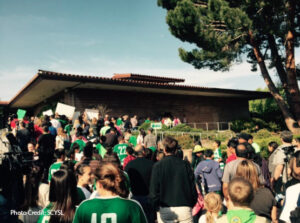
“We are committed to remaining a good neighbor to the soccer community,” York wrote.
But the next year, 49ers executive Larry MacNeil told Gillmor the team wanted to use the soccer field for VIP parking, she said. And when Gillmor later asked MacNeil about the 49ers’ plans to build the additional fields, he said they weren’t going to do that, either.
The team ultimately offered $15 million for the land on which the soccer park sits, an offer considered below market value by city officials. The 49ers withdrew their proposal after angry youth soccer players and their parents packed a raucous City Council meeting in April 2015 to protest.
Gillmor and other city officials came to view the soccer park as the first of several broken promises. Another involved the stadium curfew, a condition of the stadium development agreement between the city and team. No event could stretch past 10 p.m. on weeknights or 11 p.m. on Fridays and Saturdays.
But almost as soon as the stadium opened and started hosting non-NFL events — from which the 49ers share revenue with the city — team officials began complaining about the curfew and sometimes ignoring it. Beyoncé’s show in May 2016 extended past the prescribed time; Council Member Kathy Watanabe said she received letters from many unhappy residents who live near the stadium.
Still, to truly understand how the team’s relationship with Santa Clara began to unravel, consider the fight over kids’ soccer.
In the stadium campaign, the 49ers promised to preserve an 11-acre youth soccer park next to the stadium site. York repeated the promise in a 2012 letter to the executive board of the youth soccer league, and he said the team also would develop “several additional regulation-size soccer fields” elsewhere in Santa Clara.
“The 49ers said we’d have to change the curfew if we wanted to get good acts,” said Watanabe, who joined Gillmor in voting against Doyle’s firing Wednesday. “I had to tell them I’d hold stadium management accountable to the promises they made.”
Then there were promises of money for local schools. In their pitch to voters in 2010, the 49ers said property tax revenues would soar after the stadium was developed and that would mean a boost for Santa Clara schools.
But the team appealed its property tax bill soon after the stadium opened, and in 2019 an appeals board ruled the county assessor had set too high a value on the 49ers’ interest in the stadium. That decision gave the team an immediate $36 million refund, records show, with the promise of $170 million more in tax relief in coming years.
The assessor, Larry Stone, and several agencies (but not the city) have sued to overturn the appeals board’s decision, which forced the Santa Clara Unified School District to pay the 49ers a $13 million tax refund, according to Stone. Chandhok said the 49ers are one of the “top taxpayers” in Santa Clara County.
Many local stadium boosters felt betrayed.
“I believed what the 49ers said they were going to do,” Gillmor said. “So when they broke all these promises, there was no way I was going to stand by quietly and say it was OK, because they were hurting our community. …
“We were snow-jobbed. I’m not proud of that, but I’ll admit it.”
One day after Levi’s Stadium hosted Super Bowl 50, then-Mayor Jamie Matthews abruptly resigned on Feb. 8, 2016. Nine days later, then-Council Member Gillmor was appointed as his successor.
Soon, the simmering tension between the 49ers and Santa Clara escalated.
York requested a meeting, by Gillmor’s account, and asked for a reduction in the team’s rent. The 49ers contended they were entitled to the rollback — they initially sought a drop of $5.5 million annually, to about $19 million per year (or $220 million over the life of the lease) — because stadium construction costs had been lower and revenues higher than expected.
Gillmor told York she would agree to the reduction, she said, “if the numbers make sense and I know we’re covered.” Then Gillmor asked York to stay out of city politics. He refused, she said, citing the team’s long-term interest in Santa Clara.
Even after the 49ers reduced their request, the City Council rejected it — prompting the 49ers to take the issue to arbitration. Two years later, the arbiter sided with the city and actually raised the rent by $10 million over the life of the lease.
Chandhok responded by calling Gillmor “deceptive” and “difficult to trust.” In an email Friday, he wrote, “Unfortunately, we have no working relationship with either Mayor Gillmor or Ms. Santana. The environment they have created at City Hall is toxic and dysfunctional.”
This rent issue led to more disputes: over stadium costs, approval of contracts and the budget. And then York poured $2.9 million into last year’s election campaign.
The 49ers bought television, mail and online ads attacking the team’s City Council critics and boosting its favored candidates. The campaign rarely mentioned the team’s financial disputes with the city; instead, it said the issue was the racial makeup of the council and a plan, backed by the 49ers, to create district rather than citywide elections to improve diversity on the council.
“After seeing reports of Mayor Gillmor funneling developer money through the police union to support her slate of all-white candidates, and the outcry from the NAACP and Asian Law Alliance, we felt it necessary to make our support for diverse candidates swift, open and transparent,” Chandhok wrote in his email.
Santa Clara voters elected three of the four York-backed candidates. All three, along with two holdover council members, voted to remove Doyle as city attorney.
Gillmor said that, despite the 49ers’ contention, her duels with the team are rooted in ensuring the city receives the economic benefits promised in Measure J. That those benefits are not what Santa Clara leaders envisioned comes as no surprise to at least one observer: Noll, the Stanford economist.
He wrote an op-ed piece in The Chronicle in May 2010, a month ahead of the stadium vote. Noll warned that the city’s financial commitment could skyrocket if rosy projections in the deal turned out to be untrue.
Last month, in a phone interview, Noll said stadium deals almost always include “wildly unrealistic projections” about profits from non-football events, one of the issues in Santa Clara. Still, he was struck by how the partnership turned antagonistic more quickly than other team-city alliances.
“The thing that’s unique about the 49ers and Santa Clara is it’s very early in the relationship, and it’s very litigious,” Noll said. “Usually, the lawsuits come way later, when a team is maybe trying to break its lease.”
He’s also skeptical city officials can solve their problems by replacing the 49ers with another entity to manage Levi’s Stadium.
“They were told this was going to be a disaster by a lot of people, but they chose to ignore the experiences of other cities that went just before them,” Noll said. “This always happens with baseball and football stadiums. What happened in Santa Clara was completely predictable.”
What happens next is less certain.
Ron Kroichick is a San Francisco Chronicle staff writer, and Lance Williams is a freelance writer. Email: [email protected], [email protected] Twitter: @ronkroichick, @LanceWCIR
